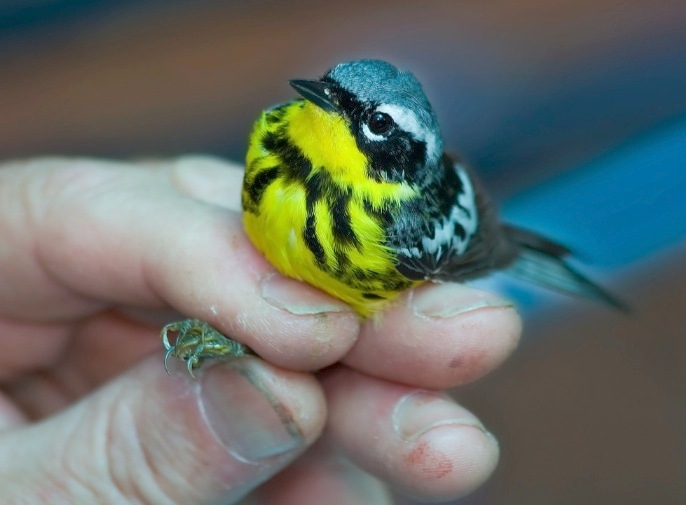One
day this spring I was fortunate enough to chance upon a bird-banding
station during a trip to a state park in Virginia. The banders
had just returned from the nets (where the birds are captured), and
they graciously invited me to join
them as they processed their latest catch.
The Banding Station
The banding
station itself consisted of a picnic table strewn with
numerous banding tools, including a rugged laptop computer into which
is
entered information about each bird captured:
The birds are brought back from the
nets in small white bags, one bird per bag. Each bag has attached
to it a clothesline clip with an alphanumeric code identifying which
net the bird was caught in, since the nets at different heights and
locations around the banding station represent different
"micro-environments" used by the birds during their various daily
activities:
Species (and Subspecies)
Identification
The birds are processed
one-by-one. To make sure the bird can't escape during handling,
the bander is very careful to use a safe, but firm grasp, in which the
bird's neck is held between two fingers, resulting in something that
looks like the avian equivalent of a "headlock":
Note that despite the firm grip used on the bird, the banders are
keenly aware of the fragility of their subjects, and are careful to
never injure them. From the image of this warbler's leg and toes
(below), you can see just how small and fragile these creatures are:
The first task for the banders is to positively identify the species,
gender, and year of the bird
(some songbirds look different during their first or second year from
how they'll look as adults). In some cases this requires the use
of a thick reference book, to be absolutely certain as to the gender,
year, and (in some cases) subspecies or geographical race:
Although other field guides are
also occasionally used, the main reference is a thick book that you
wouldn't want to
try keeping in your back pocket while birding --- it's the Identification Guide to North American
Birds, by Peter Pyle:
During the identification phase,
some birds (such as this Blue-winged Warbler) pass the time by reading
excerpts from this weighty tome*:
Here's another bird (a female
Red-winged Blackbird) that appeared to be mulling over a particularly
interesting passage in the text*:
Data Collection
Various measurements are taken from
the birds during their processing. These can be used either to
aid in
identification (i.e., the use of "morphometrics" such as size-weight
ratios to distinguish between male and female birds in some species) or
simply added to the database entry as additional information about the
physical condition of the individuals captured.
One "measurement" is the condition of the bird's plumage. Here
you can see the bander examining the primaries
and coverts on a Common
Yellowthroat:
Plumage state is difficult to
quantify precisely. Over time, the edges of feathers tend to wear
out due to abrasion, resulting in telltale signs along the edge of the
feather, such as color fringing or separation of individual feather
barbs:
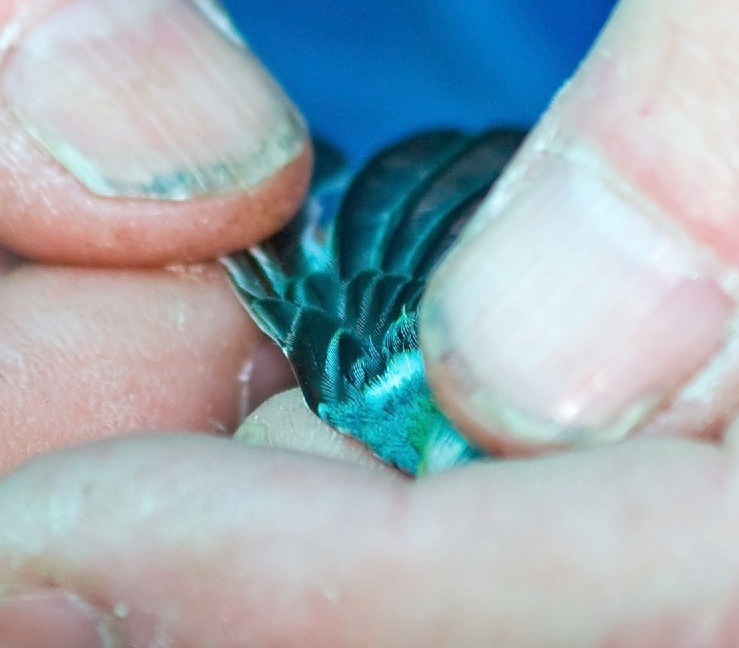
The degree of feather wear in a
bird's plumage can be
an indication of the bird's nutritional state, since birds sometimes
delay molting when living in a nutrient-poor environment. Feather
wear can also sometimes help differentiate between an adult bird and a
sub-adult.
Another
indicator of nutritional state is the amount of body fat present.
Below you can see the bander blowing on the bird's underside so as to
expose the bird's skin (which is barely visible on this individual, due
to the thick plumage). Because fat reserves provide energy for
the bird during migration, the degree to which a migrating bird
possesses subcutaneous fat deposits can indicate how likely the
bird is to reach its final destination (or, alternatively, how much
time the bird is likely to spend at re-fueling sites along the
way). Blowing on the abdomen can also reveal a brood patch (if present), in the
case of birds currently in the breeding state.
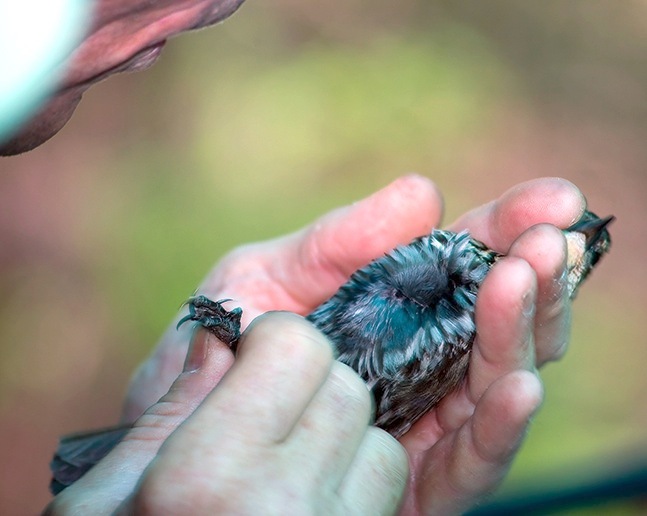
Precisely determining the age of
the bird can be very difficult, though determining whether the bird is
an adult or sub-adult can often be done reliably. In some species
the plumage differs markedly between adult and sub-adult birds.
In others, the bander has to rely on more subtle clues, such as the pneumatization
state of the bird's skull. By pushing back the
feathers on the head (see below), the bander hopes to see through the
translucent
scalp to determine whether the skull cap is fully ossified as in an
adult bird, or if it is still undergoing development (indicating that
the individual is a juvenile):
More precise measurements which can
be taken from birds in the field include the wing chord (distance from the
"wrist" to the tip of the longest primary feather) or in this case the flattened wing length:
and the tail length (length
of the longest rectrix, or
tail feather):
Sizes of smaller features such as
the length and/or depth of the beak are typically measured with
callipers (below) instead of a
ruler, for greater precision:
Banding the Bird
After all the measurements have
been taken and logged into the computer, it's time to actually band the
bird. Because the tool for applying the band is somewhat
formidable in appearance, it is shown to the bird and the process is
fully explained to the subject in a soothing voice, so that the bird
won't be afraid*:
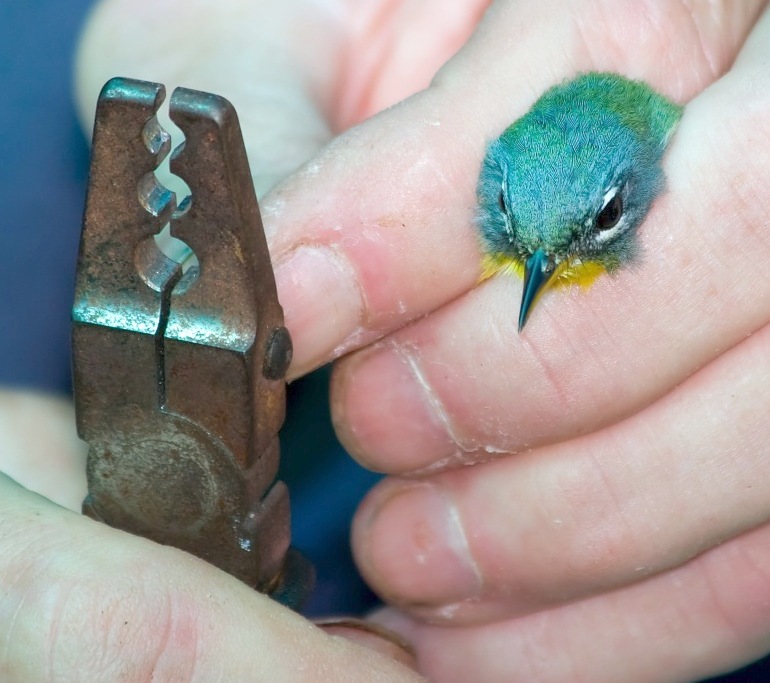
As you can see from the above
photo, different-sized bands are used for different-sized birds, and
the tool has individual grooves for the different band sizes.
Here you can see a band being closed around the leg of a female
Black-throated
Blue Warbler:
As you can see, the bands fit
loosely around the leg, so that the bird will feel no discomfort once
it's in place. It will be closed tightly enough, however, to
ensure that it does not slide up over the ankle joint (which in birds
is between the lowest and second-lowest sections of the leg), or down
over the foot.
Weighing and Release
Finally, the bird must be
weighed. Different options are available for weighing
birds. In this case, the bird is inserted into a plastic tube
(see photo
below) which rests atop a digital scale (not visible in the
photo). Since the scale has been
"zeroed-out" with the tube in place, the reading with the bird in the
tube will give the weight of the bird alone (i.e., not including the
weight of the tube).
Below you can see the actual scale that is used. Note the
Pringles canister beside the scale, which is used for larger birds such
as crows or small raptors.
Once a weight has been read from
the scale and entered into the
computer, the bird is released. Below you can see a Blue-winged
Warbler that hasn't yet realized he's free to go:
The Nets
The other major component of a
banding operation is, of course, the system of nets in place around the
banding station, which are used to catch the birds. The nets are
deployed (i.e., unfurled) only when in direct use, with banding
personnel immediately present
to ensure that birds caught in the net aren't injured or eaten by a
passing predator; when not supervised the nets are rolled up and tied
shut to prevent inadvertant capture. As you can see below, these
"mist nets" are
made from very tiny filaments, which are difficult to see when you're not
focusing exactly on them (hence their ability to catch unwary birds):
Summary
So, do the birds enjoy
being banded?
I asked this Black-throated Blue Warbler that very question, and he promptly bit the nearest
finger in front of him*:
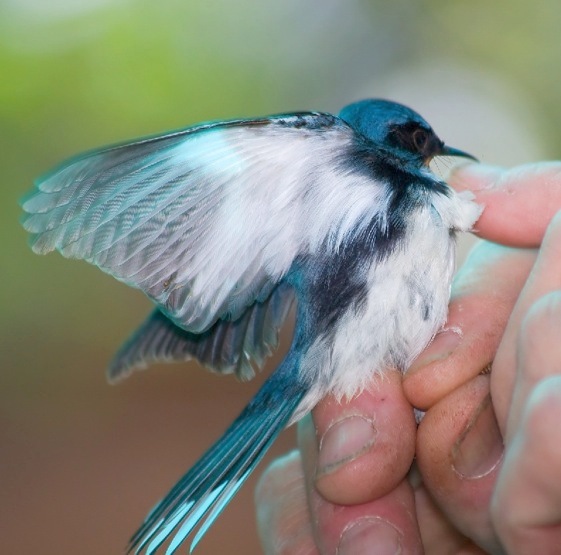
My guess is that they probably do
not overly enjoy it, though I
don't think they suffer any real trauma from the process.
The data collected during the banding process can inform policy-makers
of the need for greater efforts in the conservation of particular
species. Banded birds that are re-captured elsewhere provide
vital
information about the migration routes and re-fueling sites that are
used by the birds during their migration. Hotspots for re-fueling
during migration are obviously of great importance, and need to be
identified and
protected from environmental degradation. Finally, the data
collected
during this process can be useful for the study of bird biology, which
can itself benefit the birds in various ways.
Please note that
migratory birds are protected by law, and that the banding of wild
birds can be legally performed ONLY by licensed banders. The
banders at this site (CVWO
/ First Landing SP) were both highly trained and federally
licensed. Information on
becoming a licensed bander in the United States can be obtained from
the U.S. Geological Survey.
|




